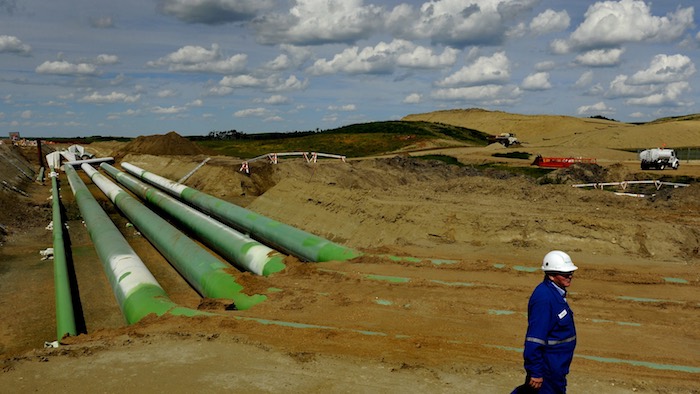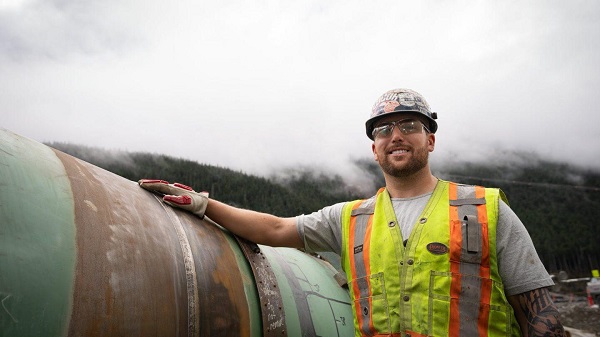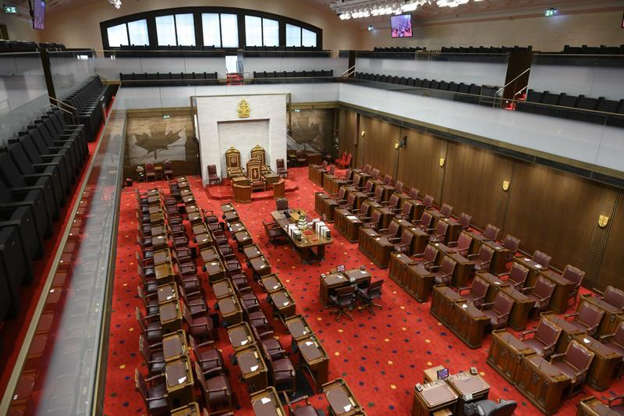Energy
What Will Be the Future of the Keystone XL Pipeline Under President Trump?

From EnergyNow.ca
By Terry Winnitoy, EnergyNow
The Keystone XL Pipeline, proposed in 2008, was designed to transport Canadian crude oil from Alberta to refineries in the United States, specifically to Steele City, Nebraska, and onward to refineries in Illinois and Texas, as well as to an oil pipeline distribution center in Cushing, Oklahoma.
Spanning approximately 1,179 miles and designed to transport up to 830,000 barrels of oil per day, the pipeline promised significant economic and energy security benefits. However, it became a focal point of political and environmental controversy, leading to its eventual cancellation by Presidents Obama and Biden.
Here’s a brief look at its history, the reasons it should have been built, the political dynamics that led to its cancellation and will President-elect Trump revive it?
Why the Keystone XL Pipeline Should Have Been Built
Economic and Job Creation
The pipeline was projected to create thousands of construction jobs and several hundred permanent jobs, providing a significant boost to the economy. It was also expected to stimulate economic activity through the development of related infrastructure and services.
Energy Security
By facilitating the efficient transport of a large volume of oil from a stable and friendly neighboring country, the pipeline would have reduced American dependence on oil imports from more volatile regions, enhancing national energy security.
Environmental Safety
Pipelines are generally safer and more environmentally friendly for transporting oil compared to rail or truck, with lower risks of spills and accidents. The Keystone XL was designed with the latest technology to minimize leaks and environmental impact.
Regulatory Oversight
The project underwent extensive environmental reviews and was subject to strict regulatory standards to ensure it adhered to environmental protection and safety measures.
Political Reasons for Cancellation
Environmental Activism
The pipeline became a symbol for environmentalists who opposed further development of fossil fuel infrastructure. They argued it would contribute to climate change by enabling the extraction and consumption of oil sands, which are more carbon-intensive than other oil sources.
Obama’s Cancellation
President Obama rejected the pipeline in 2015, citing environmental concerns and its potential impact on global climate change. He argued that approving the pipeline would have undercut America’s leadership on climate change.
Trump’s Reversal and Biden’s Final Cancellation
President Trump revived the project in 2017, citing economic benefits and energy security. However, President Biden canceled it again on his first day in office in 2021, fulfilling a campaign promise to prioritize climate change issues and transition towards renewable energy.
Political Symbolism
For both Obama and Biden, the decision to cancel the Keystone XL Pipeline was also a symbolic gesture, demonstrating a commitment to environmental sustainability and a shift away from fossil fuel dependence in line with their administrations’ climate policies.
Will President-Elect Trump Reinstate It?
Currently, there is no definitive answer on whether President-elect Trump will reinstate the Keystone XL Pipeline. His previous administration showed support for the project, citing its potential economic and energy security benefits. However, reinstating the pipeline would require navigating significant political, legal, and environmental challenges that have developed over the years.
It would also depend on the current geopolitical, economic, and environmental priorities at the time of his taking office. The Keystone XL Pipeline’s history is a complex tapestry of economic aspirations, environmental concerns, and political maneuvers.
Its cancellation has been a contentious issue, reflecting the broader national and global debates over energy policy and climate change strategy. Whether it will be reinstated remains a significant question, contingent on a multitude of factors including political will, environmental policies, and market dynamics.
That all said, re-instating its approval might be the perfect “in your face” moment for Trump to Obama and Biden as he begins his second term of presidency. We’ll have to wait and see.
2025 Federal Election
Mark Carney Wants You to Forget He Clearly Opposes the Development and Export of Canada’s Natural Resources

From Energy Now
At COP26, Mark Carney also said that he thinks “we have both far far too many fossil fuels in the world” and “as much as half of oil reserves, proven oil reserves need to stay in the ground” climate goals.
Mark Carney claims that he supports Canada’s oil and gas industry and wants to see Canada export more of our natural resources. But Carney is yet again lying.
If Carney was sincere, he would immediately commit to the full repeal of the Liberals’ C-69, the ‘No More Pipelines’ Act, C-48, the West Coast Tanker Ban, and the production cap. Instead he doubled down on capping Canadian energy production.
But it’s not just that, Mark Carney has a clear history of opposing Canadian energy and infrastructure projects in favour of his radical anti-energy ideology and his goal of shutting down Canadian energy production.
However, while deliberately fighting against Canadian energy, this high flying hypocrite was having his company, Brookfield Asset Management, invest in some of the largest global pipeline projects in Brazil and the United Arab Emirates.
When asked by Conservative Party Leader Pierre Poilievre at an Industry Committee meeting, if he supported Justin Trudeau’s decision to veto the Northern Gateway pipeline, Mark Carney said “given both environmental and commercial reasons … I think it’s the right decision.”
Then, just six months later at COP26, Mark Carney also said that he thinks “we have both far far too many fossil fuels in the world” and “as much as half of oil reserves, proven oil reserves need to stay in the ground” climate goals.
If this wasn’t enough Mark Carney has now teamed up with Trudeau’s radical anti-energy ministers to finish off Canada’s energy sector, a goal that he has outlined while attending a World Economic Forum event in Davos.
Starting with the radical, self-proclaimed socialist, Steven Guilbeault, who’s history of anti-energy and infrastructure policies is all too familiar to Canadians.
Mark Carney has enabled Steven Guilbeault to do even more damage by promoting him to his Quebec Lieutenant, giving him three new ministerial responsibilities so he can continue his climate crusade against Canadian energy and infrastructure projects.
Canadians remember when Guilbeault said that “I disagree with the [Trans Mountain] pipeline” and that “Canada shouldn’t be investing in new infrastructure for fossil fuels.”
They also remember when he proudly proclaimed that “Our government has made the decision to stop investing in new road infrastructure.” All from a minister who shamed Canadians for owning cars.
Then there is the pipeline hating Jonathan Wilkinson, who Carney appointed as Canada’s Minister of Energy and Natural Resources. Recently, Wilkinson wrote a scathing letter to Canada’s energy leaders for their opposition to the Carney-Trudeau Liberals production cap on Canadian oil and gas.
Despite Canadian industries being subject to unjustified tariffs from the United States, Jonathan Wilkinson recently told reporters that “Everybody’s sort of running around saying, ‘Oh my God, we need a new pipeline, we need a new pipeline.’ The question is, well, why do we need a new pipeline?”
Finally, there is Carney’s new Minister of Environment and Climate Change Terry Duguid. Duguid has doubled down on Mark Carney’s climate radicalism by stating that “a Mark Carney government will maintain the cap on emissions from the production of oil and gas”.
From 2015 to 2021 Carney-Trudeau environmental and anti-industry policies have cancelled over $176 billion in Canadian energy projects, with many more being cancelled afterwards. That means $176 billion worth of jobs and powerful paycheques have been blocked from Canadians so Mark Carney and his Ministers can impose their radical net zero ideology.
2025 Federal Election
Canada’s pipeline builders ready to get to work

From the Canadian Energy Centre
“We’re focusing on the opportunity that Canada has, perhaps even the obligation”
It was not a call he wanted to make.
In October 2017, Kevin O’Donnell, then chief financial officer of Nisku, Alta.-based Banister Pipelines, got final word that the $16-billion Energy East pipeline was cancelled.
It was his job to pass the news down the line to reach workers who were already in the field.
“We had a crew that was working along the current TC Energy line that was ready for conversion up in Thunder Bay,” said O’Donnell, who is now executive director of the Mississauga, Ont.-based Pipe Line Contractors Association of Canada (PLCAC).
“I took the call, and they said abandon right now. Button up and abandon right now.
“It was truly surreal. It’s tough to tell your foreman, who then tells their lead hands and then you inform the unions that those three or four or five million man-hours that you expected are not going to come to fruition,” he said.

Workers guide a piece of pipe along the Trans Mountain expansion route. Photograph courtesy Trans Mountain Corporation
“They’ve got to find lesser-paying jobs where they’re not honing their craft in the pipeline sector. You’re not making the money; you’re not getting the health and dental coverage that you were getting before.”
O’Donnell estimates that PLCAC represents about 500,000 workers across Canada through the unions it works with.
With the recent completion of the Trans Mountain expansion and Coastal GasLink pipelines – and no big projects like them coming on the books – many are once again out of a job, he said.
It’s frustrating given that this could be what he called a “golden age” for building major energy infrastructure in Canada.
Together, more than 62,000 people were hired to build the Trans Mountain expansion and Coastal GasLink projects, according to company reports.
O’Donnell is particularly interested in a project like Energy East, which would link oil produced in Alberta to consumers in Eastern and Atlantic Canada, then international markets in the offshore beyond.
“I think Energy East or something similar has to happen for millions of reasons,” he said.
“The world’s demanding it. We’ve got the craft [workers], we’ve got the iron ore and we’ve got the steel. We’re talking about a nation where the workers in every province could benefit. They’re ready to build it.”

The “Golden Weld” marked mechanical completion of construction of the Trans Mountain Expansion Project on April 11, 2024. Photo courtesy Trans Mountain Corporation
That eagerness is shared by the Progressive Contractors Association of Canada (PCA), which represents about 170 construction and maintenance employers across the country.
The PCA’s newly launched “Let’s Get Building” advocacy campaign urges all parties in the Canadian federal election run to focus on getting major projects built.
“We’re focusing on the opportunity that Canada has, perhaps even the obligation,” said PCA chief executive Paul de Jong.
“Most of the companies are quite busy irrespective of the pipeline issue right now. But looking at the long term, there’s predictability and long-term strategy that they see missing.”
Top of mind is Ottawa’s Impact Assessment Act (IAA), he said, the federal law that assesses major national projects like pipelines and highways.
In 2023, the Supreme Court of Canada found that the IAA broke the rules of the Canadian constitution.
The court found unconstitutional components including federal overreach into the decision of whether a project requires an impact assessment and whether a project gets final approval to proceed.
Ottawa amended the act in the spring of 2024, but Alberta’s government found the changes didn’t fix the issues and in November launched a new legal challenge against it.
“We’d like to see the next federal administration substantially revisit the Impact Assessment Act,” de Jong said.
“The sooner these nation-building projects get underway, the sooner Canadians reap the rewards through new trading partnerships, good jobs and a more stable economy.”
-

 International2 days ago
International2 days agoPope Francis has died aged 88
-

 International2 days ago
International2 days agoJD Vance was one of the last people to meet Pope Francis
-

 2025 Federal Election1 day ago
2025 Federal Election1 day agoOttawa Confirms China interfering with 2025 federal election: Beijing Seeks to Block Joe Tay’s Election
-

 COVID-191 day ago
COVID-191 day agoNearly Half of “COVID-19 Deaths” Were Not Due to COVID-19 – Scientific Reports Journal
-

 2025 Federal Election1 day ago
2025 Federal Election1 day agoHow Canada’s Mainstream Media Lost the Public Trust
-

 Business2 days ago
Business2 days agoCanada Urgently Needs A Watchdog For Government Waste
-

 Energy2 days ago
Energy2 days agoIndigenous-led Projects Hold Key To Canada’s Energy Future
-

 2025 Federal Election18 hours ago
2025 Federal Election18 hours agoBREAKING: THE FEDERAL BRIEF THAT SHOULD SINK CARNEY







